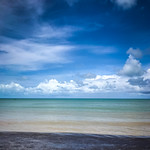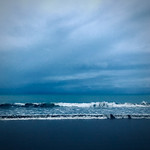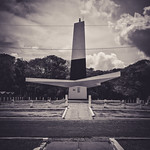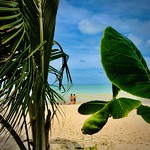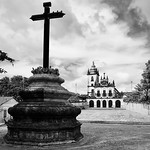Travel in the time of COVID
International travel is still heavily curtailed. Even though the COVID-19 vaccine has now started to roll out, parts of the country are still heavily affected. Manaus is having the biggest challenges, with Venezuela even sending over canisters of oxygen, clearly as a PR-stunt, but also a necessary relief, while some parts of the Brazilian northeast are also having their containment issues.
Not so João Pessoa, the capital of the state of Paraiba.
While there, we didn’t encounter many COVID-related restrictions, save for the fact that essentially everyone, everywhere, at all times, was wearing a face mask. Perhaps the underlying mentality has paid off, as nearby Recife is struggling much more.
That said, most, but not all, shared public spaces, like museums, were still closed.
João Pessoa is an hour or two north from Recife, the capital of Pernambuco, which once was the capital of Dutch Brazil, or New Holland. Joao Pessoa also has a brief Dutch history, the Dutch invading and taking the city in 1634, which at that time was called Philipeia of Our Lady of the Snows, with particularly the snowy part still on show, today, in many names of business around town. The Dutch renamed the town Fredrikstad, after Frederik Hendrik of Orange, son of William of Orange (William the Silent), the one who managed to get the Spanish to end their occupation of the northern Netherlands.
Frederik, incidentally, was born in Delft, the same town his father was murdered in. Curiously, as an aside, William’s murderer, the French catholic Balthasar Gerards, had a street named after him, in the town he was born in, Vuillafans, on the border with Switzerland, exactly because he murdered William. This, in turn, even more incidentally, was the first murder of a head-of-state with a firearm, and only the second assassination by a firearm ever recorded.
Back to Paraiba and João Pessoa.
In contrast with Recife, there is very little that remains in João Pessoa that has a Dutch connection, possibly because Dutch occupation lasted a mere 20 years, and João Pessoa played a second, and remote, fiddle to Recife. But, the expulsion of the Dutch by the Portuguese, some twenty years later, did trigger the expansion of the sugarcane industry to the Caribbean, as well as the early industrialisation of some parts of coastal North America.
One older church, in downtown Joao Pessoa, has a spire that somewhat reminds of Dutch church architecture of the time, but, as far as we could uncover, that appeared to be the extent of the connection. And even that was a stretch.
The city has undergone several name changes, with the most recent one dating back to 1930. João Pessoa was a vicepresidential candidate under Getulio Vargas, and murdered in Recife, by a slighted political opponent, of whom the police had released love letters after a raid on an opponent’s office.
João Pessoa is the least unequal city in the northeast of Brazil. The coastal zone, a long strip of beach, and where we stayed, felt decidedly pleasant, without the excesses more typical of, say, Rio de Janeiro. And even the downtown area, some 6k away from the beach, on top of a hill and, on the other side from the shore, bordered by a river, was a bit rough, but not comparable to most other larger Brazilian cities. Downtown João Pessoa has clearly not yet seen the regeneration that downtown Recife has received, but is doing much, much better compared to, say, Manaus.
The city’s main attraction, besides its beaches, and surprisingly excellent and unique food, is that the city is home to the easternmost point of the Americas (if you don’t include Greenland as part of the Americas). The spot that is marked as such was recently highlighted with one of Oscar Niemeyer’s final constructions.
However, oddly, the spot that is marked as the most eastern point isn’t actually the most eastern point of the Americas. A point, about 1km south from the marked spot, is significantly further east. But, the rest of the cape, further east than the marked point, appears all privately owned, which presumably made it more difficult to turn the spot into a bit of a tourist attraction.
The city’s geography does hit home, once more, the size of the country; In João Pessoa, we’re closer to Cape Verde, than we are to both Manaus, deep in the Brazilian Amazon, and Porto Alegre, in Brazil’s south, while both are still quite a bit away from the Brazilian border themselves. In fact, parts of Brazil close to the Peruvian border are further away from João Pessoa than parts of Morocco-occupied Western Sahara, or Accra, the capital of Ghana.
Renaming cities seems a bit of a national pastime in Brazil. The nearby town of Bayeux is home to the city’s airport. From 1635 onwards, this town used to be called Barreiros, but was renamed in 1944, in honour of the first French town to be liberated in the battle of Normandy, that is, D-Day, on June 7 of that year.
I was hoping for some connection to the tapestry of the city, but, although Bayeux has been settled for 100s of years, there appeared little of history that remains.
Also, in true Brazilian style, emphasised by the country’s current president, playing fast-and-loose with facts is also not too uncommon. The city is known as the second greenest city in the world, after Paris. But, this was a stunt, initiated by the city’s mayor, in the context of an Earth Summit (Eco-92), which was held in 1992 in Rio de Janeiro.
In fact, it appears that Joao Pessoa is not even the greenest city in Brazil, with Curitiba often being referred to as the greenest city on earth.
We thoroughly enjoyed João Pessoa. People are friendly and laid back, while the city prospers reasonably well. The coastal strip and its beaches are gorgeous, the food is great, while prices are reasonable.
Food wise, we found many experimental restaurants, as well as a unique local style, often cooking with cream. One interesting import were Hungarian chimney cakes, the delightfully called Kürtöskalács, stuffed with sweets, including ice cream.

